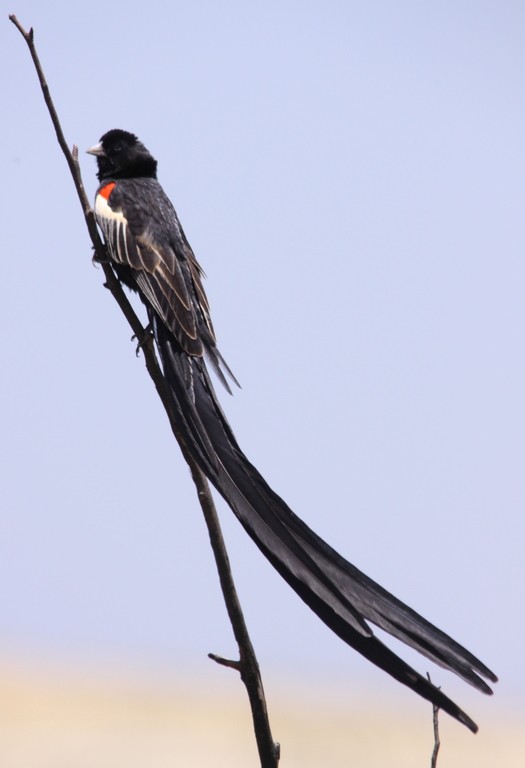Long-tailed Widowbird
A species of Bishops and widowbirds, Also known as Sakabula Scientific name : Euplectes progne Genus : Bishops and widowbirds
Long-tailed Widowbird, A species of Bishops and widowbirds
Also known as:
Sakabula
Botanical name: Euplectes progne
Genus: Bishops and widowbirds
Content
Description General Info
Description
Long-tailed widowbirds exhibit distinct sexual dimorphism. Males and females exhibit differences in behavior and morphological traits. Adult males are entirely black, including under their wing-coverts. Males' wing shoulders are orange red and their wing-coverts white. Their bills are bluish white. Males are known for their distinctly long tails, which contain twelve tail feathers. Of these twelve tail feathers, between six and eight are approximately half a metre (approximately 20 inches) long. Males have wingspans of approximately 127 to 147 mm (approximately 5 to 5.8 inches). Females have a rather subdued coloration. The upper portion of the female's body is streaked with buff or tawny and black. Female chests, breasts and flanks are slightly paler than their above coloring. The area under the wing-coverts is black and the females' tail feathers are narrow and pointed. Finally, their bills are horn-coloured. Non-breeding males are slightly larger than females, though they demonstrate a remarkably similar appearance. For the most part, these males are colored in the same manner as the females, except in that they are more broadly streaked above and below and have wings and wing shoulders with the morphology of the breeding class of males. Rarely, males in the non-breeding class have elongated brownish black tail feathers, though these feathers are substantially shorter than those of the breeding class. Immature males and females are very similar in appearance to the adult female. However, immature males, much like adult non-breeding males, are slightly larger than adult females. 
Size
71 cm
Nest Placement
Shrub
Feeding Habits
Long-tailed Widowbird primarily consume seeds from various grasses and grains, punctuated by arthropods. They forage in groups on the ground and aerially hunt insects, indicating a flexible foraging strategy. Unique preferences include seeds from specific grasses like Setaria sphacelata and Paspalum species.
Habitat
The long-tailed Widowbird primarily occupies grassland environments, from swampy grasslands to areas with shorter grass, including both highland and lowland regions across broader geographical areas. It is adaptable to various elevations, with a range extending up to 2,750 meters in mountainous areas. The long-tailed Widowbird can be found in large flocks, particularly in roosting habitats like reed beds during the non-breeding season. While favoring grasslands for breeding and feeding, its capability for flight is hindered in wet conditions due to its distinctive long tail.
Dite type
Granivorous
General Info
Feeding Habits
Bird food type
Distribution Area
There are three known isolated populations of long-tailed widowbirds. The first is found in the Kenyan highlands, the second in Angola, southern Zaire and Zambia, and the third in southern Africa. It is unknown when these populations were last in contact, however, and the central population differs most in morphology relative to the other two populations. The southern African population extends from the Eastern Cape (Transkei region) through the Free State, Lesotho, KwaZulu-Natal, and western Swaziland to the Transvaal plateau. The species just enters southeastern Botswana, but is most commonly found in the central highveld of South Africa. Long-tailed widowbirds are generally found in swampy grassland in flocks consisting of one or two males and a number of females. The males fly with their tails drooping and somewhat spread, and with slow regular movements of their wings. In wet weather, they are unable to fly due to their elongated tails. During the non-breeding season, long-tailed widowbirds congregate into flocks, which can be found roosting in reed beds. The long-tailed widowbird can be found at elevations up to 2,750 metres (9,022 feet) in the Drakensberg Mountains. 
Species Status
The long-tailed widowbird has a very large range, and so the species would not be classified as vulnerable under the range size criterion put forward by BirdLife International which include that the extent of occurrence being less than 20,000 km (7722 miles) combined with a declining or fluctuating range size, habitat extent/quality, or population size and a small number of locations or severe fragmentation. The population is stable according to the population trend criterion, which requires a greater than 30% decline over ten years or three generations, and would not be considered vulnerable for this reason. While the total population size has not yet been quantified, it is not believed that the long-tailed widowbird is approaching the threshold for being considered vulnerable under the population size criterion (less than 10,000 mature individuals with a continuing decline estimated to be greater than 10% in ten years or three generations, or with a specified population structure). For these reasons, the species is evaluated as least concern. 
Scientific Classification
Phylum
Chordates Class
Birds Order
Perching birds Family
Weavers Genus
Bishops and widowbirds Species
Long-tailed Widowbird 